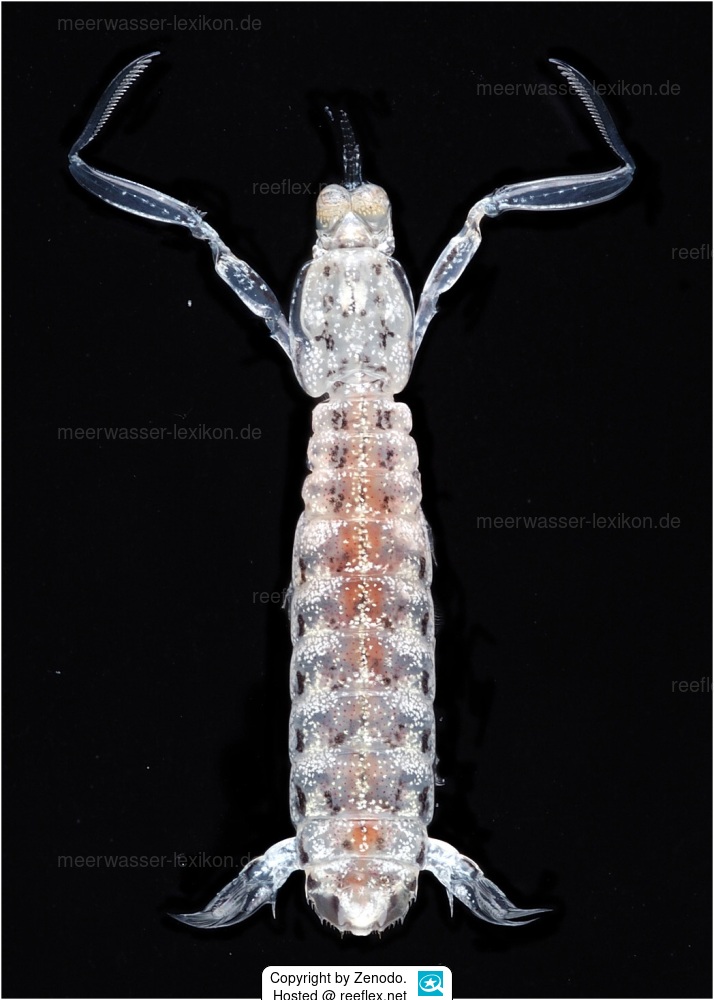Info
Pullosquilla decocki is a very small mantis shrimp belonging to the Nannosquillidae family, which in turn consists of more than 13 genera, one of which is Pullosquilla.
This sand-dwelling mantis shrimp species is now the fifth species described in the genus Pullosquilla and was discovered in the waters around Vanuatu, an island nation in Oceania in the South Pacific consisting of around 80 islands.
What does “small” mantis shrimp mean?
The sampling site was located at a depth of 1 to 3 meters below the water's surface and has rough coral sand. It was found in Port Benier Bay, Aoré Island, Vanuatu.
Using a LD31 type Warén dredge, a trawl net, a specimen, the female holotype, was landed with a total length of an incredible 1.5 centimeters. The carapace length of this miniature sea predator was 2.64 millimeters and the length of the propodium of the predatory claws was 3.08 millimeters.
The body of Pullosquilla decocki is translucent overall, with the carapace, thorax, and abdomen speckled with white chromatophores, densest on the sides and along the midline, with scattered black-brown chromatophores and tiny red chromatophores in two rows on both sides of the midline and along the lateral margins.
The rapacious claws and uropods are covered with scattered white chromatophores.
In the female holotype, “mature” orange gonads are visible through the cuticle along the midline of the abdomen.
Due to the small size of the mantis shrimp and its sand-dwelling lifestyle, it is very likely that further sightings of this small marine predator will be reported in the coming years.
Etymology: Named after Wim Decock on the occasion of his retirement from the Flanders Marine Institute (VLIZ). Wim was an important member of the data management team at WoRMS (World Register of Marine Species; www.marinespecies.org) for more than 16 years.
Admin note:
Over the past few years, I have frequently contacted Wim about species not yet listed in WoRMS, and he has always recorded the new species at lightning speed, enabling us to add the correct Latin names of these species to the marine encyclopedia.
We would like to take this opportunity to wish you, dear Wim, all the best for your retirement, which began at the end of May 2025.
Reference Source:
Ahyong, S. T. (2025). FIGURE 3 in First mantis shrimp of the genus Pullosquilla Manning, 1978, from Vanuatu (Crustacea: Stomatopoda: Nannosquillidae), with a key to the species. In Zootaxa (Bd. 5621, Nummer 5, S. 587–593). Zenodo. https://doi.org/10.5281/zenodo.15263234
Creative Commons Zero v1.0 Universal
This sand-dwelling mantis shrimp species is now the fifth species described in the genus Pullosquilla and was discovered in the waters around Vanuatu, an island nation in Oceania in the South Pacific consisting of around 80 islands.
What does “small” mantis shrimp mean?
The sampling site was located at a depth of 1 to 3 meters below the water's surface and has rough coral sand. It was found in Port Benier Bay, Aoré Island, Vanuatu.
Using a LD31 type Warén dredge, a trawl net, a specimen, the female holotype, was landed with a total length of an incredible 1.5 centimeters. The carapace length of this miniature sea predator was 2.64 millimeters and the length of the propodium of the predatory claws was 3.08 millimeters.
The body of Pullosquilla decocki is translucent overall, with the carapace, thorax, and abdomen speckled with white chromatophores, densest on the sides and along the midline, with scattered black-brown chromatophores and tiny red chromatophores in two rows on both sides of the midline and along the lateral margins.
The rapacious claws and uropods are covered with scattered white chromatophores.
In the female holotype, “mature” orange gonads are visible through the cuticle along the midline of the abdomen.
Due to the small size of the mantis shrimp and its sand-dwelling lifestyle, it is very likely that further sightings of this small marine predator will be reported in the coming years.
Etymology: Named after Wim Decock on the occasion of his retirement from the Flanders Marine Institute (VLIZ). Wim was an important member of the data management team at WoRMS (World Register of Marine Species; www.marinespecies.org) for more than 16 years.
Admin note:
Over the past few years, I have frequently contacted Wim about species not yet listed in WoRMS, and he has always recorded the new species at lightning speed, enabling us to add the correct Latin names of these species to the marine encyclopedia.
We would like to take this opportunity to wish you, dear Wim, all the best for your retirement, which began at the end of May 2025.
Reference Source:
Ahyong, S. T. (2025). FIGURE 3 in First mantis shrimp of the genus Pullosquilla Manning, 1978, from Vanuatu (Crustacea: Stomatopoda: Nannosquillidae), with a key to the species. In Zootaxa (Bd. 5621, Nummer 5, S. 587–593). Zenodo. https://doi.org/10.5281/zenodo.15263234
Creative Commons Zero v1.0 Universal







 Zenodo
Zenodo

